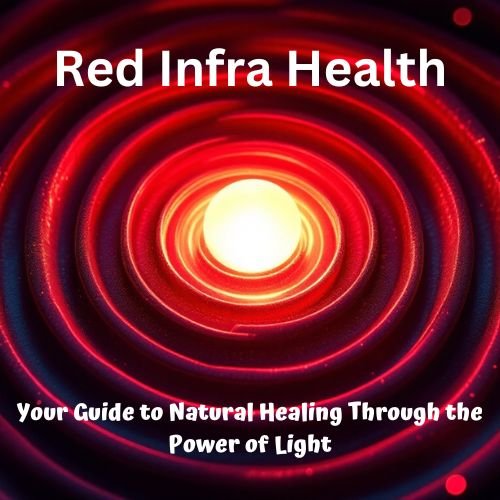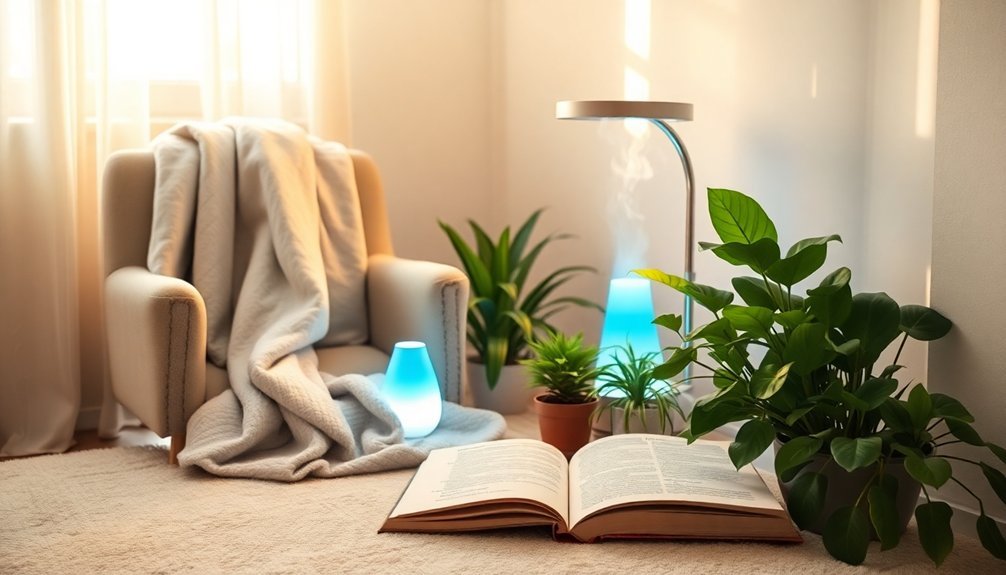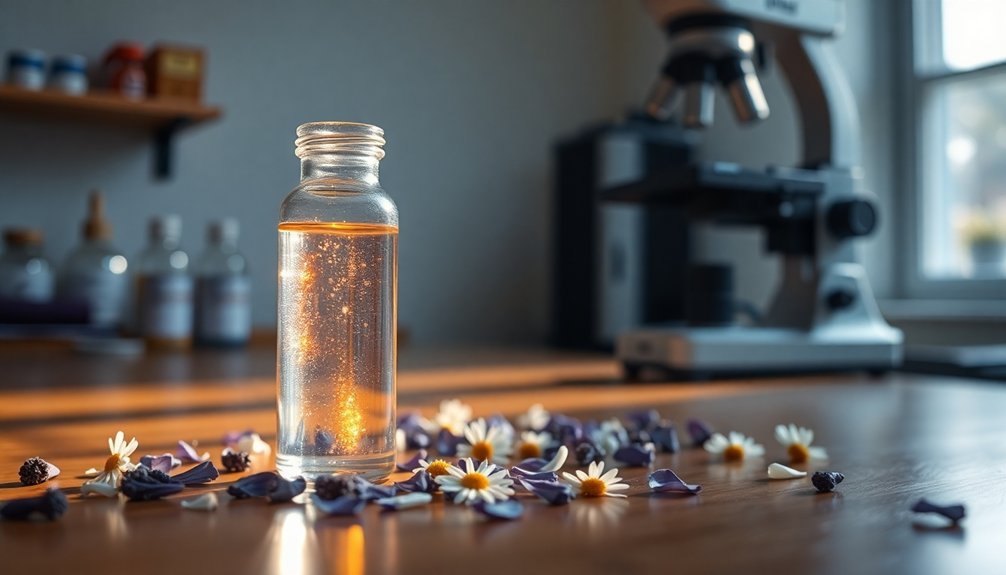Modern skin therapies can effectively turn back your biological clock by targeting multiple aging mechanisms at once. When you undergo treatments like LED light therapy, microneedling, or professional facials, you're activating your skin's natural repair processes. These techniques boost collagen production, repair DNA damage, and stimulate cellular regeneration at a deep level. They work by addressing both intrinsic aging (your natural aging process) and extrinsic aging (damage from environmental factors). Your skin responds by increasing blood flow, enhancing cellular turnover, and rebuilding its structural support – and that's just scratching the surface of what these revolutionary treatments can accomplish.
Understanding Your Skin's Aging Clock

Time silently ticks away in your skin through two distinct aging mechanisms: intrinsic and extrinsic aging. Your skin's internal clock operates through cellular senescence, where your cells naturally accumulate damage over time.
As your fibroblasts age, they release factors that break down your skin's extracellular matrix, compromising its structural integrity. Your aging skin experiences a decline in sweat and sebum production, leading to increased dryness and sensitivity.
While you can't stop your internal aging clock, you're actively influencing your external one through daily environmental exposure. UV radiation is your skin's biggest enemy, triggering harmful photochemical reactions that accelerate aging, especially if you've got lighter skin.
Environmental pollutants further compound this damage by increasing oxidative stress in your skin cells.
Your aging clock's speed depends on how these factors interact with your skin's biochemistry. When you're exposed to these stressors, your skin experiences increased CCN1 expression, which disrupts collagen production and promotes inflammation.
Think of it as your skin's aging accelerator – the more it's activated, the faster your skin shows signs of aging. Understanding these mechanisms is essential because it helps you make informed decisions about protecting and treating your skin effectively.
Collagen Production Through Light Therapy
Your skin's cells respond powerfully to specific LED wavelengths, with red and near-infrared light penetrating deeply to activate fibroblast growth factors.
These wavelengths work directly with your skin's mitochondria to boost cellular energy and enhance natural collagen production. This non-invasive treatment safely stimulates your skin's rejuvenation without any needles or chemicals.
You'll see the most significant benefits when red light therapy targets the ideal wavelength range of 630-850 nanometers, stimulating cellular repair mechanisms and promoting the formation of new blood vessels.
LED Wavelength Benefits
Light therapy has emerged as a powerful solution for aging skin, with different wavelengths offering unique benefits for collagen production and skin rejuvenation. When you're looking to boost your skin's health, each wavelength targets specific concerns. Originally developed by NASA, light therapy was created to help astronauts heal wounds more quickly while in space.
Red light penetrates deep into your dermis, stimulating fibroblast cells and increasing collagen production while reducing inflammation. Blue light works wonders for acne-prone skin by eliminating bacteria and reducing oil production in your sebaceous glands.
Near-infrared light delivers the deepest penetration, reaching well into your dermis to enhance collagen synthesis and promote tissue repair. You'll find this wavelength particularly effective when combined with red light for thorough anti-aging results.
- Red light boosts blood circulation and reverses sun damage while promoting youthful skin
- Blue light specifically targets and destroys acne-causing bacteria in your pores
- Near-infrared light stimulates both collagen and elastin production for firmer skin
- All wavelengths work together to provide painless, non-invasive treatment without downtime
This therapeutic approach is safe for most skin types and can address multiple concerns simultaneously, from wrinkles and fine lines to skin texture and tone. You'll experience smoother, firmer skin through consistent treatment sessions.
Cellular Repair Mechanisms
Cells within your skin undergo remarkable transformations when exposed to LED therapy, activating essential repair mechanisms that boost collagen production. Your skin's fibroblasts respond to specific red and near-infrared wavelengths by accelerating collagen synthesis, while simultaneously reducing inflammation that typically hinders repair processes. Matrix metalloproteinases decrease during light therapy, helping preserve the extracellular matrix integrity.
| Mechanism | Impact on Your Skin |
|---|---|
| Fibroblast Activation | Triggers new collagen formation in deeper layers |
| Enhanced Blood Flow | Delivers crucial nutrients to repair damaged tissue |
| Inflammation Reduction | Removes barriers to cellular regeneration |
You'll experience deeper cellular benefits as the near-infrared light penetrates into your dermis, where it stimulates tissue regeneration and prevents cellular aging. This non-invasive approach works particularly well when combined with other treatments like microdermabrasion, maximizing your skin's rejuvenation potential.
The clinical applications of LED therapy extend beyond basic anti-aging treatments. Whether you're dealing with rosacea, acne, or sun damage, the enhanced collagen production helps restore your skin's natural resilience. Research consistently shows that regular LED therapy sessions lead to significant improvements in skin texture and firmness, offering you long-term benefits without downtime or discomfort.
Cellular Repair Using Infrared Light

Through advanced technological breakthroughs, infrared light therapy has emerged as a powerful tool for cellular repair and regeneration. When you expose your skin to red and near-infrared light, it penetrates deep into your cells, triggering a cascade of healing responses.
Your mitochondria, the powerhouses of your cells, become energized and produce more ATP, giving your skin cells the energy they need to repair and regenerate.
The therapy's power lies in its ability to stimulate your body's natural healing processes. You'll experience enhanced collagen production, reduced inflammation, and improved blood circulation. Your skin's antioxidant defenses strengthen, protecting you from environmental damage while supporting cellular repair mechanisms.
- Your fibroblasts become more active, producing fresh collagen that helps reduce wrinkles and fine lines
- Your blood vessels dilate, delivering more oxygen and nutrients to skin cells
- Your body's natural healing processes accelerate, helping wounds heal faster
- Your cells' defense systems strengthen, protecting against oxidative stress
This non-invasive approach works with your body's natural processes, making it safe and effective for all skin types. You'll notice improvements in skin texture, tone, and overall health as your cells repair and rejuvenate.
Deep Tissue Rejuvenation Methods
Professional microneedling combined with PRP therapy reaches deep into your skin's layers to trigger natural healing and collagen production.
You'll see enhanced results when this treatment pairs with radiofrequency energy, which delivers controlled heat to rebuild dermal collagen networks more effectively.
Your skin's deeper tissues respond to these combined therapies by accelerating cellular turnover and creating stronger, more resilient dermal structures.
Professional Microneedling Benefits
Three remarkable benefits make microneedling a standout choice for deep tissue rejuvenation. Your skin immediately responds to the tiny needle punctures by stimulating collagen and elastin production, leading to improved texture and quality.
Unlike chemical peels, microneedling proves safer with minimal recovery time – you'll experience only temporary redness that resolves within 1-1.5 days.
You'll find microneedling particularly effective for treating multiple skin concerns simultaneously. It effectively reduces scarring, blackheads, and hyperpigmentation while addressing signs of aging like fine lines and wrinkles. What's more, it's more cost-effective than laser treatments and safer for darker skin tones since it doesn't involve heat.
- You'll see up to 80% improvement in surgical and burn scars
- Your skin's hydration levels will increase, reducing dullness
- Your pore size will visibly decrease, improving overall texture
- Your body's natural healing process will boost collagen formation
The procedure combines beautifully with radiofrequency technology for enhanced results. Through microneedling's therapeutic mechanisms, you'll experience natural skin rejuvenation as fibroblasts create new collagen, effectively turning back your skin's aging clock.
Dermal Collagen Rebuilding Techniques
Multiple proven techniques can effectively rebuild dermal collagen and restore your skin's youthful structure. You'll find both non-invasive and minimally invasive options that target collagen production through different mechanisms.
Microneedling creates controlled micro-injuries to your skin, triggering your body's natural healing response and boosting collagen synthesis.
Radio frequency treatments deliver energy deep into your dermis, stimulating existing collagen fibers while promoting new collagen formation. For more pronounced results, you can combine these methods through radio frequency microneedling.
Sculptra injections work gradually by introducing poly-L-lactic acid to rebuild your skin's inner structure. You'll see progressive improvements as your body produces new collagen in response to the treatment.
Hyaluronic acid-based treatments, whether through topical applications or dermal fillers, support your skin's moisture balance and complement collagen production.
Since collagen levels naturally decline by about 25% over four decades starting in your mid-20s, it's crucial to adopt these rebuilding techniques early.
You can enhance results by combining professional treatments with daily care routines that include collagen-supporting ingredients like retinol and hyaluronic acid serums.
Light Wavelengths For Skin Health

Through advances in light therapy technology, specific wavelengths of light have emerged as powerful tools for skin health and rejuvenation. You'll find that different wavelengths penetrate your skin at varying depths, delivering targeted benefits for multiple skin concerns.
Red light (630-700nm) and infrared light (780nm-1mm) work deep within your skin's layers to boost collagen production and repair tissue, while blue light (400-495nm) effectively tackles surface issues like acne and enlarged pores.
The versatility of LED light therapy makes it an attractive option for addressing various skin concerns:
- Red light reduces inflammation and supports anti-aging by stimulating collagen production
- Blue light eliminates acne-causing bacteria and helps regulate oil production
- Green light breaks down excess melanin to even out your skin tone
- Infrared light penetrates deepest, promoting healing and tissue repair
LED light therapy is non-invasive and generally safe when used correctly. However, it's essential to follow treatment guidelines and consult healthcare providers before starting any light therapy regimen.
While this emerging treatment shows promise, proper precautions help prevent potential side effects from misuse or prolonged exposure.
Epigenetic Changes From Light Treatment
When you undergo light-based skin treatments, you're actually triggering profound epigenetic changes at the DNA level through mechanisms like DNA methylation and histone modification.
Your skin cells respond to specific wavelengths of light by altering their gene expression patterns, which can help restore more youthful cellular behavior and function.
Light therapy's ability to reprogram cellular activity makes it a powerful tool for reversing aging-related changes in your skin, particularly when combined with other epigenetic interventions like Epicelline.
Light-Triggered DNA Methylation
Recent scientific discoveries have revealed light therapy's profound impact on DNA methylation patterns, a key epigenetic mechanism in skin rejuvenation.
Research shows that LED therapy at 1.6 J/cm² increases DNA methylation and enhances wound healing by boosting Dnmt3a expression. These molecular changes directly influence your skin's ability to repair and rejuvenate itself.
Light therapy's effects on DNA methylation aren't limited to LED treatments. UV exposure can alter epigenetic patterns in your epidermis, though it's crucial to mention that UVB can affect methylation modifier enzymes in ways that may contribute to skin cancer. However, controlled light therapy can positively reactivate silenced genes and reverse aging signs.
- Your skin's DNA methylation patterns naturally change with age, leading to epigenetic erosion
- Aging skin shows increased methylation that silences youth-associated genes
- LED therapy can strategically modify these patterns to promote healing
- Combining light therapy with treatments like Epicelline can restore youthful epigenetic patterns
This scientific breakthrough explains why light-based treatments effectively combat aging – they're actually reprogramming your skin's genetic activity at the molecular level.
Cellular Reprogramming Through Phototherapy
Light's transformative power extends beyond surface-level skin changes, reaching deep into your cells' epigenetic programming. When you undergo phototherapy treatments, specific wavelengths of light trigger molecular changes that can effectively reset your skin cells' biological clock, upregulating genes associated with youth while downregulating those linked to aging.
During phototherapy, your skin cells respond to light signals by altering their DNA methylation patterns – a key mechanism in epigenetic control. You'll notice these changes manifest through increased collagen production, improved skin texture, and enhanced melanin synthesis when needed. The effects aren't just temporary; they can last for months as your cells maintain their reprogrammed state.
What makes phototherapy particularly exciting is its ability to target multiple aging pathways simultaneously. When you receive fractional laser treatments, they'll induce specific gene expression changes that contribute to skin rejuvenation without altering your genetic code.
Your skin's response to these treatments can be measured using epigenetic clocks, confirming the biological age reduction in treated areas. These light-based interventions represent a sophisticated approach to skin rejuvenation, working at the molecular level to restore youthful cellular function.
Measuring Biological Skin Age

Scientists and researchers employ several sophisticated methods to measure biological skin age, going far beyond simple visual assessments.
Your skin's biological age can be determined through RNA expression analysis, which examines patterns in skin surface lipids without causing damage. In this method, RNA expression information from skin surface lipids (SSL-RNA) is analyzed to estimate the biological age of the skin. This approach has been shown to correlate with skin aging more accurately than chronological age, especially when using machine learning to analyze the data.
Epigenetic clocks offer another precise measurement by analyzing how lifestyle factors like diet and sun exposure affect your skin's genetic code. These clocks use DNA methylation patterns to determine biological age, which can reflect the impact of environmental factors on skin aging. For instance, increased DNA methylation is associated with skin aging and can be influenced by factors such as UV exposure and diet[4'.
Clinical imaging techniques, including VISIA and dynamic optical coherence tomography (D-OCT), provide detailed assessments of your facial characteristics. These tools can effectively evaluate different aging subtypes and measure various skin features that indicate your true biological age.
- RNA analysis captures 368 different markers that correlate with chronological aging
- Epigenetic patterns reveal how environmental factors have impacted your skin
- Clinical scales assess multiple facial characteristics simultaneously
- Advanced imaging devices measure specific features like wrinkles, pores, and UV damage
While there's no universal consensus on the best measurement method, these advanced techniques offer increasingly accurate estimates of your skin's biological age. Scientists continue to gather data and refine these methods, helping to develop more effective anti-aging treatments tailored to your specific needs.
Professional Light Therapy Results
After understanding your skin's biological age through advanced measurements, you'll want to explore effective treatment options. Professional LED light therapy delivers powerful results through customized treatments that target your specific skin concerns. You'll notice improvements in collagen production, inflammation reduction, and overall skin health without any downtime.
| Treatment Color | Benefits You'll See |
|---|---|
| Red Light | Reduces fine lines and boosts collagen production |
| Blue Light | Eliminates acne-causing bacteria and calms breakouts |
| Yellow Light | Soothes inflammation and helps with rosacea |
| Green Light | Evens skin tone and diminishes dark spots |
You'll need a series of weekly treatments for the first month to achieve the best results. While at-home devices can help maintain results, professional treatments deliver higher light frequencies for more dramatic improvements. Your dermatologist will customize the treatment plan based on your skin's needs, and you can return to normal activities immediately after each session. Remember to avoid sun exposure for 48 hours post-treatment and wear protective goggles during sessions. You'll see gradual improvements that become more noticeable with consistent treatments, making this therapy an effective choice for reversing visible signs of aging.
Daily Anti-Aging Light Protocols

Establishing a consistent daily red light therapy routine maximizes your anti-aging results. You'll want to start with 10-15 minute sessions using red light wavelengths between 620-660 nm, positioned 12-36 inches from your skin.
For ideal results, maintain 3-5 sessions weekly during your initial 4-6 week treatment phase, then switch to 1-2 maintenance sessions per week.
Your skin type matters when determining the right dosage. If you have lighter skin, you'll need lower doses, while darker skin types can typically handle higher intensities.
Don't exceed 120 joules per session, and always space your treatments at least 6 hours apart.
Here's your daily anti-aging protocol checklist:
- Position yourself 12-36 inches from the light source, adjusting based on comfort and skin sensitivity
- Start with 10-minute sessions at 20-50 mW/cm², gradually increasing to 15 minutes as your skin adapts
- Apply the therapy consistently at the same time each day for best results
- Monitor your skin's response and adjust the distance or duration if you experience any sensitivity
Remember to cleanse your face before each session and protect your eyes during treatment.
Future of Light-Based Therapies
Through remarkable technological advances, light-based therapies are revolutionizing the future of anti-aging skincare. You'll see groundbreaking developments in how these treatments combat aging, with new technologies making treatments more effective and accessible than ever before.
| Technology | Current Benefits | Future Potential |
|---|---|---|
| Low-Level Lasers | Collagen stimulation, minimal recovery | Integration with at-home devices |
| IPL/BBL | Pigmentation reduction, skin tightening | Full-body rejuvenation systems |
| Fractional Lasers | Targeted skin repair, reduced downtime | Enhanced precision targeting |
| HBOT | Biological aging reversal | Combined therapy protocols |
| Photodynamic Therapy | Specific cell targeting | Advanced visualization methods |
You'll benefit from emerging research that's combining these technologies with other anti-aging treatments. The integration of HBOT with light-based therapies shows particular promise, as it's proven to reverse biological aging markers. Scientists are developing new ways to visualize skin cells during treatment, leading to more precise and personalized protocols. You can expect future devices to offer thorough body rejuvenation, not just facial treatments, while maintaining safety for all skin types and conditions, including during pregnancy.
Frequently Asked Questions
Can Retinoids Permanently Reverse Skin Damage From Long-Term Smoking?
While retinoids can't permanently reverse smoking's skin damage, they'll help improve your skin's appearance by boosting collagen production, reducing wrinkles, and improving texture through consistent long-term use and proper skincare.
How Do Hormonal Changes Affect the Effectiveness of Anti-Aging Treatments?
Your hormonal fluctuations can substantially impact anti-aging treatments' effectiveness. During menopause, you'll notice reduced collagen production and skin hydration, which means you might need higher concentrations or combined therapies for the best results.
Are There Genetic Markers That Predict Which Anti-Aging Treatments Work Best?
Yes, your retroelement markers and DNA methylation patterns can predict treatment success. You'll get better results when doctors match anti-aging therapies to your specific genetic profile and epigenetic age markers.
Do Anti-Aging Treatments Work Differently on Ethnic Skin Types?
Yes, your ethnic skin type will respond differently to anti-aging treatments. You'll need treatments tailored to your melanin levels, as darker skin is more prone to hyperpigmentation but naturally shows fewer wrinkles.
Can Epigenetic Skin Treatments Interfere With Necessary Cellular Aging Processes?
Yes, epigenetic treatments can interfere with natural aging processes. You'll need careful monitoring, as altering your cells' aging mechanisms might disrupt normal cellular functions and homeostasis. It's best to seek professional guidance.
In Summary
Your skin's biological clock can be reset through targeted light therapy treatments. You'll see remarkable changes as specific wavelengths stimulate collagen production and cellular repair. Whether you're using professional treatments or at-home devices, consistent light therapy protocols will help reverse visible aging signs. As technology advances, you're gaining more powerful tools to maintain youthful, healthy skin. Don't wait – start your light therapy journey today.





Leave a Reply